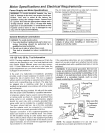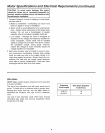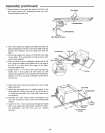
Motor Specifications and Electrical Requirements (continued)
CAUTION: To avoid motor damage, this motor
should be blown out or vacuumed frequently to
prevent sawdust buildup which will interfere with
normal motor ventilation,
1 Frequent "blowing" of fuses or tripping of circuit break-
ers may result if:
a Motor is overloaded - Overloading can occur if you
feed too rapidly or if saw is misaligned
b, Motor circuit is fused differently from recommenda-
tions - Always follow instructionsfor the proper fuse/
breaker Do not use a fuse/breaker of greater
capacity without consulting a qualified electrician
c Low voltage - Although the motor is designed for
operation on the voltage and frequency specified on
motor nameplate, normal loads will be handled
safely on voltage not more than 10% above or below
the nameplate voltage Heavy loads, however,
require that voltage at motor terminals equals the
voltage specified on nameplate,
2. Most motor troubles may be traced to loose or incor-
rect connections, overloading, reduced input voltage
(such as small size wire in the supply circuit) or to
overly long supply circuit wire, Always check the con-
nections, the load and the supply circuit whenever
motor fails to perform satisfactorily Check wire sizes
and length with the Wire Size Chart below
Wire Sizes
NOTE: Make sure the proper extension cord is used and
is in good condition
The use of any extension cord will cause some loss o!
power To keep this to a minimum and to prevent over-
heating and motor burn-out, use the table shown to
determine the minimum wire size (AWG,) extension
cord
Use only 3-wire extension cords which have 3-prong
grounding type plugs and 3-prong receptacles which
accept the tool's plug
Extension
Cord Length
0-25 Ft,
26-50 Ft
Wire Sizes Required
for (A.W.G.)
16
16


















